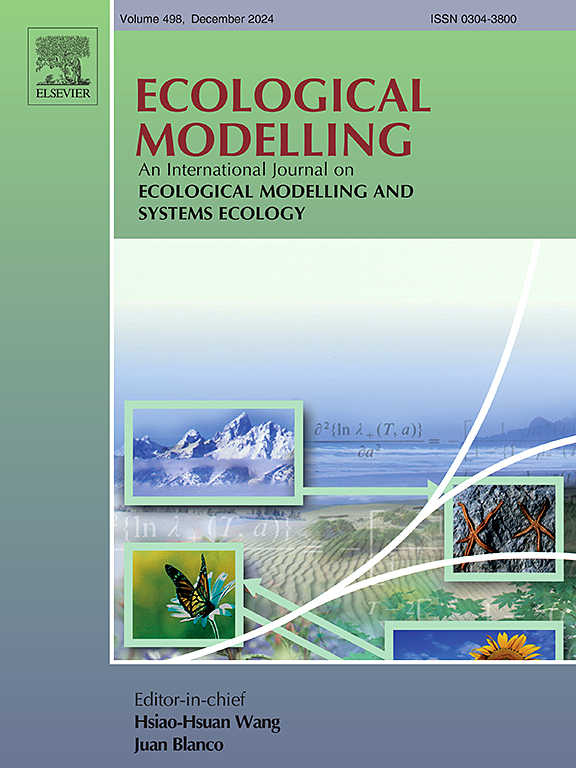Exploring aquaculture related traits of the grooved carpet shell (Ruditapes decussatus) in relation to other bivalve species using Dynamic Energy Budget theory
IF 3.2
3区 环境科学与生态学
Q2 ECOLOGY
引用次数: 0
Abstract
To assess the potential of the grooved carpet shell (Ruditapes decussatus) for aquaculture in Europe, we used Dynamic Energy Budget (DEB) theory to perform extensive parametrization on the species and compared its energy allocation strategy with those of commonly farmed bivalve species: mussels (Mytilus edulis and Mytilus galloprovincialis), oysters (Ostrea edulis and Magallana gigas), the common cockle (Cerastoderma edule), and great scallop (Pecten maximus). The comparison was based on DEB primary parameters relevant to aquaculture production, such as maximum assimilation rate and kappa, which represents the fraction of energy allocated to maintenance and growth, and compound parameters like the von Bertalanffy growth coefficient and maximum storage density. Furthermore, we evaluated the production efficiency at the population level, which represents the ratio of assimilated energy converted into biomass. Our results revealed notable differences in energy utilization strategies among species. However, uncertainties in parameter estimation and environmental factors challenge the direct translation of these parameters to real-world aquaculture, therefore our interpretation focuses on how these parameters might influence a species’ potential for aquaculture. The grooved carpet shell exhibits a balanced energy allocation strategy with a low growth coefficient and low maintenance costs, leading to high production efficiency. Similarly, the common mussel focuses on growth with significant biomass investment over reproduction, while the Pacific oyster and Mediterranean mussel prioritize reproductive development. The flat oyster and scallop demonstrate rapid growth at the cost of the low production efficiencies. The grooved carpet shell and mussels face constraints such as limited reserves, making them comparatively more susceptible to low food quality and quantity. In contrast, high storage densities in species like the common cockle, scallop, and Pacific oyster suggest resilience to fluctuating food conditions. These findings, along with both agreements and discrepancies with existing literature, highlight the need for further experimental research to refine DEB parameters and enhance their application in aquaculture. Overall, the DEB framework proves effective for exploring aquaculture traits across species and underscores the need for additional work on temperature-related processes, life-history events, and morphological variation.

利用动态能量预算理论,探讨沟纹地毯贝(Ruditapes decussatus)与其他双壳贝类的水产养殖相关特征
为了评估沟纹地毯贝(Ruditapes decussatus)在欧洲的水产养殖潜力,我们使用动态能量预算(DEB)理论对该物种进行了广泛的参数化,并将其能量分配策略与常见的养殖双壳贝类物种进行了比较:贻贝(Mytilus edulis和Mytilus galloprovincialis)、牡蛎(Ostrea edulis和Magallana gigas)、普通毛蚶(Cerastoderma edule)和扇贝(Pecten maximus)。比较依据的是与水产养殖生产相关的 DEB 主要参数,如最大同化率和 kappa(代表分配给维持和生长的能量部分),以及复合参数,如 von Bertalanffy 生长系数和最大储存密度。此外,我们还评估了种群水平的生产效率,即同化能量转化为生物量的比率。我们的研究结果表明,不同物种的能量利用策略存在明显差异。然而,参数估计和环境因素的不确定性对将这些参数直接转化为实际水产养殖提出了挑战,因此我们的解释侧重于这些参数可能如何影响物种的水产养殖潜力。沟纹地毯贝表现出均衡的能量分配策略,生长系数低,维护成本低,因而生产效率高。同样,普通贻贝注重生长,大量生物量投资超过繁殖,而太平洋牡蛎和地中海贻贝则优先考虑生殖发展。平牡蛎和扇贝以较低的生产效率为代价实现了快速增长。槽毯贝和贻贝面临储备有限等制约因素,使其相对更容易受到食物质量和数量低下的影响。与此相反,普通毛蚶、扇贝和太平洋牡蛎等物种的高储存密度表明,它们对波动的食物条件有很强的适应能力。这些发现以及与现有文献的一致和不一致之处,突出表明需要进一步开展实验研究,以完善DEB参数并加强其在水产养殖中的应用。总之,DEB框架证明可有效探索不同物种的水产养殖特征,并强调需要在温度相关过程、生活史事件和形态变异方面开展更多工作。
本文章由计算机程序翻译,如有差异,请以英文原文为准。
求助全文
约1分钟内获得全文
求助全文
来源期刊

Ecological Modelling
环境科学-生态学
CiteScore
5.60
自引率
6.50%
发文量
259
审稿时长
69 days
期刊介绍:
The journal is concerned with the use of mathematical models and systems analysis for the description of ecological processes and for the sustainable management of resources. Human activity and well-being are dependent on and integrated with the functioning of ecosystems and the services they provide. We aim to understand these basic ecosystem functions using mathematical and conceptual modelling, systems analysis, thermodynamics, computer simulations, and ecological theory. This leads to a preference for process-based models embedded in theory with explicit causative agents as opposed to strictly statistical or correlative descriptions. These modelling methods can be applied to a wide spectrum of issues ranging from basic ecology to human ecology to socio-ecological systems. The journal welcomes research articles, short communications, review articles, letters to the editor, book reviews, and other communications. The journal also supports the activities of the [International Society of Ecological Modelling (ISEM)](http://www.isemna.org/).
 求助内容:
求助内容: 应助结果提醒方式:
应助结果提醒方式:


